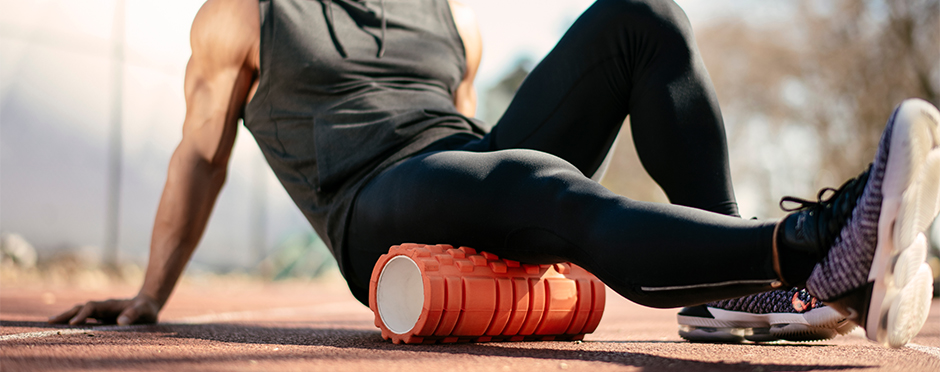
Stop, Drop And Roll: Should You Be Using A Foam Roller?
Leave a CommentFoam rollers have become a staple in many physical therapy clinics and gyms. If you have never seen one before, it is a 3 ft x 6-inch foam cylinder that can be used for stretching and massaging muscles during the recovery process as well as pre and post-workout. While it is a simple looking tool, there are many ways to use it. Many people swear by the benefits of foam rolling stating that it helps them feel more limber and reduce pain. These claims certainly sound good, but what does rolling out your muscles actually do and could it be a beneficial tool for you?
Foam Rolling Effects
Some people claim that rolling out your muscles is a great way to stretch and break up sore “knots.” However, at the muscle tissue level there have been many studies that confirm that the muscle tissue and connective tissue do not actually lengthen or become smoother through using the pressure of a foam roller. So why do people feel better and more limber after foam rolling? Studies have shown that tissue massage, which happens as you foam roll, increases blood flow and reduces nerve receptor sensitivity in the specific area that has been rolled for a short time. Oftentimes, the effects of increased blood flow and reduced nerve sensitivity to stretch and nociception (pain) receptors allows someone to have more range of motion.
Foam Rolling For Recovery
So far, we have established that foam rolling in fact does not lengthen muscles or fascia, and has a temporary impact on blood flow and a person’s ability to stretch with less sensitivity. Some people also use foam rolling as a massage after a workout or cool down. Again, rolling the tissue does increase blood flow to an area which then increases oxygen and helps to flush out any built-up lactic acid, which in theory should improve recovery and perhaps reduce muscle soreness associated after intense exercise. The results are mixed as to whether or not foam rolling actually reduces muscle soreness overall after exercise, but there are other variables to consider including the psychological effect of a self-massage related to pain.
Other Ways To Use A Foam Roller
In addition to rolling, there is another common use for foam rollers. Many people will lay lengthwise along the spine on their foam roller with their head, spine, and tailbone all resting on the roller. In this position, the person reaches their arms out in a “T” position. This is a gentle way to stretch the neck, chest, and spine and can be helpful when working to improve spinal posture.
Key Takeaways
- Foam rolling should not replace stretching or exercise.
- Foam rolling can help to get you moving more comfortably or help with recovery.
- If foam rolling makes it easier to stay moving and/or exercise, that is a great reason to use one.
- You can also use the foam roller for spinal and chest stretching to improve posture.
While foam rollers do not actually help to lengthen your tissues or break up painful spots in muscles, they can be helpful for improving blood flow and making stretching more tolerable. For many people, this helps them to be more comfortable when stretching or exercising. A tool that helps a person exercise and stretch with less pain is beneficial because it encourages them to exercise more frequently, which is good for health and progression with training or recovery. Foam rolling can also aid in recovery by improving tissue blood flow after a workout. Let’s not forget that sometimes it just feels good! If you are someone that likes the feeling of deep tissue massage, foam rollers can be a reward before and after exercise.
If you have questions about how to best use a foam roller to address your specific needs, make sure to read more on the Athletico blog by visiting the Health Resources section on our website. You can also visit one of our clinics and request a free assessment with a physical therapist for guidance with pain or wellness goals. Free Assessments are available in-clinic and virtually through our Telehealth services.
*Per federal guidelines, beneficiaries of plans such as Medicare, Medicaid, Tricare, VHA and other federally funded plans are not eligible for free assessments.
The Athletico blog is an educational resource written by Athletico employees. Athletico bloggers are licensed professionals who abide by the code of ethics outlined by their respective professional associations. The content published in blog posts represents the opinion of the individual author based on their expertise and experience. The content provided in this blog is for informational purposes only, does not constitute medical advice and should not be relied on for making personal health decisions.
References:
1. Beardsley, C., Skarabot, J. (2015). Effects of self-myofascial release: A systematic review. Journal of Bodywork and Movement Therapies. https://www.sciencedirect.com/science/article/pii/S136085921500217X?casa_token=yxgXKqGThZcAAAAA:nCy1hA0lpuIUxY5_KoUW2F_hWZElGAm_sI2d9dNfPFH39_ze4MUggUyw4AGED5eqZ4uDhsLlIWo
2. MacDonald, G., Button, D., Drinkwater, E., & Behm, D. (2014). Foam rolling as a recovery tool after an intense bout of physical activity. Medicine & Science in Sports & Exercise. https://journals.lww.com/acsm-msse/Fulltext/2014/01000/Foam_Rolling_as_a_Recovery_Tool_after_an_Intense.19.aspx
3. Adamczyk JG, Gryko K, Boguszewski D. Does the type of foam roller influence the recovery rate, thermal response and DOMS prevention? PLoS One. 2020 Jun 26;15(6):e0235195. doi: 10.1371/journal.pone.0235195. PMID: 32589670; PMCID: PMC7319325 https://www.ncbi.nlm.nih.gov/pmc/articles/PMC7319325/
